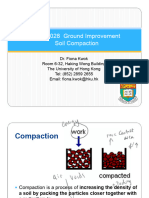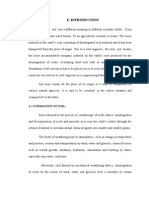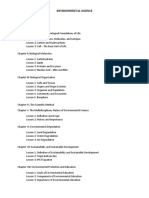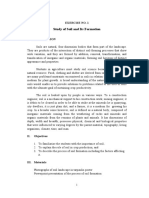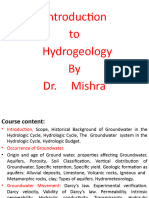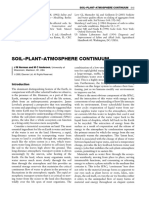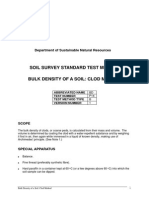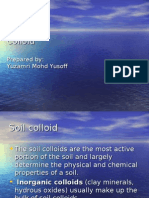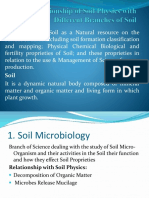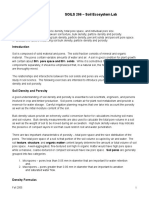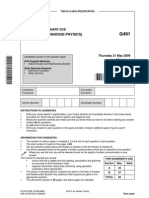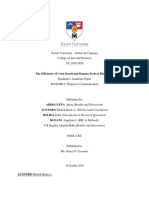Particle Density and Bulk Density
Particle Density and Bulk Density
Uploaded by
yener9331Copyright:
Available Formats
Particle Density and Bulk Density
Particle Density and Bulk Density
Uploaded by
yener9331Copyright
Available Formats
Share this document
Did you find this document useful?
Is this content inappropriate?
Copyright:
Available Formats
Particle Density and Bulk Density
Particle Density and Bulk Density
Uploaded by
yener9331Copyright:
Available Formats
Page 1 of 5
http://weather.nmsu.edu/Teaching_Material/Soil252/CHAPT5.HTM, 29.03.2012
Chapter 5 BULK DENSITY AND PARTICLE DENSITY
Bulk Density (Db) Soil bulk density, like all density measurements, is an expression of the mass to volume relationship for a given material. Soil bulk density measures total soil volume. Thus, bulk density takes into account solid space as well as pore space. Soils that are loose, porous, or well-aggregated will have lower bulk densities than soils that are compacted or nonaggregated. This is because pore space (or air) weighs less than solid space (soil particles). Sandy soils have less total pore than clayey soils, so generally they have higher bulk densities. Bulk densities of sandy soils vary between 1.2 to 1.8 Mg m-3. Fine-textured soil, such as Clays, silty clays, or clay loams, have bulk densities between 1.0 and 1.6 Mg m-3. Farmers often speak of 'heavy' and 'light' soils in relation to the ease of tillage. 'Heavy' soils are clayey and difficult to till, while 'light'soils are sandy and easy to till. These terms are misnomers in the technical sense because sandy soils are heavier per unit volume than clayey soils. Remember that sandy soils have less pore space than clayey soils, so in a given volume of both soils, the sandy soil has less air (more solid soil particles) and is therefore heavier. The terms 'heavy' and 'light' actually refer to other physical properties of the soil, such as plasticity, cohesion, adhesion, etc. which determine the soil's ease of tillage. Bulk density is an indirect measure of pore space and is affected primarily by texture and structure. As aggregation and clay content increase, bulk density decreases (Figure 5.1). Tillage operations do not affect texture, but they do alter structure (soil particle aggregation). Primary tillage operations, such as plowing, generally decrease bulk density and increase pore space, which is beneficial. Secondary tillage (cultivation) generally increases bulk density and decreases pore space. The compaction resulting from cultivation can be detrimental to plant growth. Cropped soils generally have higher bulk densities than uncropped soils. The movement of machinery over the field forces solid particles into spaces once occupied by water or air, resulting in less pore space and increased bulk density. >---------BULK DENSITY INCREASING----------> Clayey Loamy Sandy Well-aggregated Moderately aggregated Nonaggregated High organic Moderate organic Low organic matter Matter content matter content content
http://weather.nmsu.edu/Teaching_Material/Soil252/CHAPT5.HTM
29.03.2012
Page 2 of 5
>-----------BULK DENSITY INCREASING--------> Figure 5.1. Relationship of soil bulk density to texture, organic matter content, and aggregation. The density of water is 1.0 Mg m-3 and mineral soils are usually heavier than water. However, organic soils generally have a bulk density less than water. As the organic matter content of mineral soils increases, the bulk density decreases (Figure 6.1). Manure additions in large amounts tend to lower the surface bulk density of mineral soils because of the addition of low bulk density material and the consequent promotion of soil aggregation. Soil bulk density increases with soil depth primarily because of less organic matter and decreased aggregation. Measurement of Soil Bulk Density Measurement of soil bulk density involves the determination of the mass and the volume of a given amount of soil material. These two measurements can be obtained in a variety of ways. Some of these methods are listed below. Clod Method - Bulk density is best measured on an undisturbed sample. One method of determining Db of soils in their natural state is to use large soil peds or clods. Clod volume is determined by coating with a water repellant substance, such as paraffin or saran, then making use of Archimedes Principle. Archimedes Principle states that a mass immersed in water will displace it's own volume. Db can them be calculated by first weighing the coated clod suspended in water and then in air. Core Methods - Another method of determining Db of soils under natural conditions is to obtain a core or cylinder of soil, of known volume, by driving or pushing a core sampler into the soil. The soil extracted from the sampler is oven dried and weighed. Excavation Method - In this method a quantity of soil is excavated, oven dried and, weighed. The volume of the hole left is measured by filling the hole with either sand or water and measuring the volume needed to fill the hole. In the water method, a balloon is placed in the hole and is filled with water from a graduated vessel. Radiation Method - Measurement of either gamma radiation transmission or scattering can be used to estimate Db. The transmission technique requires the boring of two holes into the soil. A probe containing a source of gamma radiation is lowered into one hole. A second probe containing a geiger counter is lowered into the other hole. With proper calibration, the rate at which gamma radiation passes through the soil can be used to estimate Db. In the scattering method, the gamma radiation source and the geiger counter are lowered into a single hole. The detector then measures the gamma rays that 'bounce back' from the soil. Particle Density (Dp) Soil particle density is a measure of the mass per unit volume of the soil solids only.
http://weather.nmsu.edu/Teaching_Material/Soil252/CHAPT5.HTM
29.03.2012
Page 3 of 5
Texture and structure do not affect particle density. However, organic matter, which is a soil solid, readily influences particle density. Organic matter weighs much less per unit volume than soil minerals. Soils high in organic matter have lower particle densities than soils similar in texture that are low in organic matter. Soil particle density generally increases with soil depth because of the concurrent decrease in organic matter. Particle density varies with the type of soil minerals present as well as the amount of organic matter. The particle density of most mineral soils is in the range of 2.60 to 2.75 Mg m-3. Particle density is used in the calculation of pore space and bulk density on a coarse fragment free basis. When unknown, particle density of mineral soils is assumed to be 2.65 Mg m-3. Generally quartz, feldspars, and colloidal silicates dominate the mineral fraction of soils. The particle density of these minerals averages about 2.65 Mg m-3. When large amounts of heavy minerals, such as hornblende or magnetite, are present, the soil particle density is greater than 2.65 Mg m-3. Soils formed in volcanic parent materials, such as pumice or ash, generally have particle densities less than 2.65 Mg m-3. Soil particle density is determined using Archimede's Principle. Laboratory Exercise The instructor will demonstrate measurement of soil bulk density by the excavation method and the core method. The laboratory exercise also includes a determination of soil particle density. A. Soil Bulk Density: Excavation Method 1) In the laboratory: Weigh a clean, dry beaker empty. 2) In the field: Excavate a hole in the soil using a soil bucket auger and empty all the soil from the auger into a clean, dry bucket. 3) Tamp down the soil at the bottom of the hole so that it is smooth and flat. 4) Measure the depth and the diameter (for calculation of the volume) of the hole and record on the data sheet. 5) Fill the hole to the top with clean sand, keeping track of the volume of sand needed to fill the hole. Record the volume of sand used to fill the hole on the data sheet. 6) In the laboratory: Weigh the soil and bucket and record on the data sheet. 7) Transfer soil to container for oven drying and place in the oven. 8) Obtain the data for the oven-dry weight of soil from the laboratory instructor the
http://weather.nmsu.edu/Teaching_Material/Soil252/CHAPT5.HTM
29.03.2012
Page 4 of 5
following day. B. Soil Particle Density 1) Weigh a clean, dry pyconometer with the ground glass stopper to the nearest 0.01 g. 2) Transfer about 10 g of soil to the pyconometer, replace the stopper, and reweigh. This allows the exact weight of soil to be determined. 3) Add water to the pyconometer until it is about 2/3 full. Leaving the stopper out, heat the pyconometer carefully on a hot-plate. Gently boil the water to remove any air entrapped in the soil. Do not leave unattended. 4) Cool the pyconometer to room temperature, fill to the brim with water, and insert the stopper so that water shoots out the hole in the stopper. This ensures that no air is trapped in the pyconometer. The entire volume, including the stopper, should now be free of air. 5) Carefully dry the outside of the pyconometer and weigh to the nearest 0.01 g. 6) Remove all the soil from the pyconometer and fill completely with water only. Insert the stopper as before, wipe the outside dry, and reweigh. 7) Calculate particle density (Dp). DATA SHEET Chapter 5 A. Soil Bulk Density: Excavation Method 1. Soil core weight a) Weight clean, dry beaker, empty _________g b) Weight beaker and soil _________g c) Weight soil (by difference) (b-a) _________g d) Oven-dry weight soil _________g e) Gravimetric moisture _________% 2. Soil volume
http://weather.nmsu.edu/Teaching_Material/Soil252/CHAPT5.HTM
29.03.2012
Page 5 of 5
Geometrically Directly a) Depth of hole ________ cm a) Volume sand used to fill hole b) Diameter of hole ________ cm ________ cm3 c) Volume of hole ________ cm3 (Note: Volume = ( ) (radius)2 (depth) 3. Soil bulk density a) Geometrically ________ g cm-3 (Mg m-3) b) Directly ________ g cm-3 (Mg m-3) DATA SHEET CHAPTER 5 B. Soil Particle Density 1. Weight empty, clean, dry pyconometer ________g 2. Weight pyconometer and soil ________g 3. Weight pyconometer, water, and soil ________g 4. Weight pyconometer and water ________g 5. S = (line 2 - line 1) ________g 6. W = (line 4) ________g 7. X = (line 3) ________g 8. Particle density = __S__ ________ g cm-3 W-X+S (Mg m-3)
http://weather.nmsu.edu/Teaching_Material/Soil252/CHAPT5.HTM
29.03.2012
You might also like
- Apes Soil LabDocument5 pagesApes Soil Labapi-236697820No ratings yet
- BRAHMS KRYPTOR Compact PLUS User Manual English 70302Document30 pagesBRAHMS KRYPTOR Compact PLUS User Manual English 70302Gustavo Rivas100% (1)
- Lab 2 Soil Density and PorosityDocument5 pagesLab 2 Soil Density and PorosityAsante LeslieNo ratings yet
- Principal of Soil Science (Practical)Document30 pagesPrincipal of Soil Science (Practical)Sarwar M. Rasheed67% (3)
- 1st Mid PartDocument13 pages1st Mid PartAbdullah Al Mamun100% (1)
- Soil Physics Exp: 1. To Study The Relationship Between The Physical Properties of Soil and DepthDocument3 pagesSoil Physics Exp: 1. To Study The Relationship Between The Physical Properties of Soil and DepthAamir khanNo ratings yet
- Soil Bulk Density Lab ReportDocument9 pagesSoil Bulk Density Lab ReportDana KellyNo ratings yet
- Soil Physical Properties - 03!02!2023Document68 pagesSoil Physical Properties - 03!02!2023Gabby ChebetNo ratings yet
- Lancrop - Interpreting Soil AnalysisDocument7 pagesLancrop - Interpreting Soil AnalysisHernando MontenegroNo ratings yet
- Soil Texture AnalysisDocument10 pagesSoil Texture AnalysisMarkPNo ratings yet
- Chapter-1-Intro SoilDocument103 pagesChapter-1-Intro Soilkylle autorNo ratings yet
- Chapter 2 Soil-Water-PlantDocument50 pagesChapter 2 Soil-Water-PlantMūssā Mūhābā ZēĒthiopiāNo ratings yet
- SL 101 - Soil Chemical PropertiesDocument44 pagesSL 101 - Soil Chemical PropertiesNeville TNo ratings yet
- Lecture 1 and 2 - FUNDAMENTALS OF SOIL SCIENCEDocument40 pagesLecture 1 and 2 - FUNDAMENTALS OF SOIL SCIENCEAnshumaanNo ratings yet
- Laboratory Act 2.Document2 pagesLaboratory Act 2.Shekinah MontecirNo ratings yet
- 2.soil Physics IDocument32 pages2.soil Physics ISilvio GumiereNo ratings yet
- Chapter One-Introduction To Soil: January 2017Document28 pagesChapter One-Introduction To Soil: January 2017YosephNo ratings yet
- Soil Compaction 1Document56 pagesSoil Compaction 1Louis BrightonNo ratings yet
- Soil Physics: The Solid Phase: Nature and Behavior of ClayDocument23 pagesSoil Physics: The Solid Phase: Nature and Behavior of ClayAndrae GenusNo ratings yet
- SOIL FormationDocument12 pagesSOIL FormationIka Bayu KartikasariNo ratings yet
- Stablisation of SoilDocument105 pagesStablisation of Soilmeena100% (1)
- Topics For Environmental ScienceDocument5 pagesTopics For Environmental ScienceRoeliza De leonNo ratings yet
- Importance of Soil and 14 Best UsesDocument2 pagesImportance of Soil and 14 Best Usesadipoliachayan5235No ratings yet
- Lesson 3 - Soil ConsistencyDocument31 pagesLesson 3 - Soil Consistencychvi.plucena.auNo ratings yet
- Lab 2Document4 pagesLab 2Matthew BumanglagNo ratings yet
- Eduardo P. Paningbatan, Jr. PHD Professor of Soil PhysicsDocument90 pagesEduardo P. Paningbatan, Jr. PHD Professor of Soil PhysicsQuinnee VallejosNo ratings yet
- Soil Physics ExerciseDocument14 pagesSoil Physics ExerciseChanako DaneNo ratings yet
- QuestionnaireDocument4 pagesQuestionnaireDiether DavidNo ratings yet
- Chapter 1-Introduction To Ecological PrinciplesDocument49 pagesChapter 1-Introduction To Ecological PrinciplesMuhammad DanialNo ratings yet
- L3 - Atterbergs Limit, Soil ConsistencyDocument36 pagesL3 - Atterbergs Limit, Soil ConsistencySeaWhat SeasNo ratings yet
- CE 3A03 - Geotechnical Engineering I: Lab Instructions Lab 1: Compaction Test 1. ObjectiveDocument4 pagesCE 3A03 - Geotechnical Engineering I: Lab Instructions Lab 1: Compaction Test 1. ObjectivefostbarrNo ratings yet
- HPPT 1Document127 pagesHPPT 1manaseessau5No ratings yet
- Cropping System Cropping SystemDocument8 pagesCropping System Cropping Systemyoutube premiumNo ratings yet
- 1st Sem Syllabus For B.SC Agri For MPKVDocument23 pages1st Sem Syllabus For B.SC Agri For MPKVVIKRAM9350% (4)
- CarbonCycleBackground PDFDocument12 pagesCarbonCycleBackground PDFMusdq ChowdhuryNo ratings yet
- Soil Colloids, Properties, Types and Their SignificanceDocument10 pagesSoil Colloids, Properties, Types and Their SignificanceAvighna PNo ratings yet
- Soil Plant Atmoshere Continuum PDFDocument9 pagesSoil Plant Atmoshere Continuum PDFAnuragNo ratings yet
- Soil Structure, Density, and Porosity: Laboratory #4Document32 pagesSoil Structure, Density, and Porosity: Laboratory #4ZevanyaRolandTualakaNo ratings yet
- Soil Structure and FabricDocument33 pagesSoil Structure and FabricVigknaraja JagathesanNo ratings yet
- Soil Erosion and Conservation 1Document66 pagesSoil Erosion and Conservation 1Cyrone Partusa100% (1)
- Soil Fertility and Plant Nutrition: Rogelio R. Picart JR., Lic. AgrDocument14 pagesSoil Fertility and Plant Nutrition: Rogelio R. Picart JR., Lic. AgrMelody DacanayNo ratings yet
- Lecture Topic: SoilsDocument6 pagesLecture Topic: SoilsNikhil TutejaNo ratings yet
- Tackling of Alkaline Soil and Brackish Water in Pakistan and Improvement of Urea and CAN Fertilizers Efficiency PDF 2Document11 pagesTackling of Alkaline Soil and Brackish Water in Pakistan and Improvement of Urea and CAN Fertilizers Efficiency PDF 2RanaNaqushbandKhanNo ratings yet
- Stwes Class GlasodDocument5 pagesStwes Class GlasodNadya Anggi HastitiNo ratings yet
- Soil MechanicsDocument123 pagesSoil MechanicsAloke Majumder100% (2)
- Bulk DensityDocument3 pagesBulk DensitysachinismuNo ratings yet
- Principles of Soil Science Module 1 Genesis, Morpholgy and ClassificationDocument51 pagesPrinciples of Soil Science Module 1 Genesis, Morpholgy and ClassificationRamos, Keith A.No ratings yet
- Lecture 4 SST3005Document32 pagesLecture 4 SST3005Sleeping BeautyNo ratings yet
- Soil Moisture ContentDocument2 pagesSoil Moisture ContentdrjkbsNo ratings yet
- SOL507Document2 pagesSOL507Mahendra paudel PaudelNo ratings yet
- Estimating Soil TextureDocument6 pagesEstimating Soil TextureChe Che BartiletNo ratings yet
- Absorption Water Content and Liquid LimitDocument7 pagesAbsorption Water Content and Liquid LimitChandan BleeNo ratings yet
- Soil As A ResourceDocument32 pagesSoil As A Resourcehoabeo1984No ratings yet
- Physical Properties of SoilsDocument11 pagesPhysical Properties of SoilsTarpan ChakmaNo ratings yet
- Soil ColloidDocument29 pagesSoil Colloidyuzamri100% (3)
- Relationship of Soil Physics With Different Branches ofDocument8 pagesRelationship of Soil Physics With Different Branches ofAli RazaNo ratings yet
- CompactionDocument15 pagesCompactionpp hsu100% (6)
- Lab 2-Soil Physical Properties IIDocument10 pagesLab 2-Soil Physical Properties IIAji IpaNo ratings yet
- Density and Porosity SOILS 206 - Soil Ecosystem Lab: ObjectivesDocument5 pagesDensity and Porosity SOILS 206 - Soil Ecosystem Lab: ObjectivesRamesh KonakallaNo ratings yet
- PorosityDocument13 pagesPorosityRamesh Konakalla0% (1)
- Soils as a Key Component of the Critical Zone 5: Degradation and RehabilitationFrom EverandSoils as a Key Component of the Critical Zone 5: Degradation and RehabilitationChristian ValentinNo ratings yet
- Ocr 41610 PP 09 Jun Gce g491 01Document20 pagesOcr 41610 PP 09 Jun Gce g491 01cotswoldstone-temp070111No ratings yet
- 2024 - CO2 To Ethylene (SOEC - Cu Based Catalyst)Document34 pages2024 - CO2 To Ethylene (SOEC - Cu Based Catalyst)swaggeroni yololoNo ratings yet
- Company Profile GIG - 2022 - Low VerDocument49 pagesCompany Profile GIG - 2022 - Low Verfqdjhgdjd9No ratings yet
- Amine Best Practices GuideDocument63 pagesAmine Best Practices GuideJerold100% (3)
- Marine Catalog KemenanganDocument12 pagesMarine Catalog KemenanganInggrid P.CNo ratings yet
- FrassDocument152 pagesFrassManikanta SwamyNo ratings yet
- Science 10 Q4 WK5 6Document23 pagesScience 10 Q4 WK5 6Roselie Duldulao100% (1)
- Pengaruh Rasio Diameter Pipa Terhadap Perubahan Tekanan Pada Bernoulli Theorem ApparatusDocument6 pagesPengaruh Rasio Diameter Pipa Terhadap Perubahan Tekanan Pada Bernoulli Theorem Apparatuscindy aprillia arfaniNo ratings yet
- Is 4332 (Part V) - 1970Document24 pagesIs 4332 (Part V) - 1970giriNo ratings yet
- Notes 02 - First Order SystemsDocument2 pagesNotes 02 - First Order SystemsMan JaNo ratings yet
- (IQC) LG (67) - G3-1213 - Decor Assembly - Detailed Inspection ProcedureDocument10 pages(IQC) LG (67) - G3-1213 - Decor Assembly - Detailed Inspection ProcedureAnonymous Lta32Ta9No ratings yet
- CL 6 Nstse 2021 Paper 465 KeyDocument5 pagesCL 6 Nstse 2021 Paper 465 KeyAadityaNo ratings yet
- Some Important Textile Processing Machines and Their FunctionsDocument4 pagesSome Important Textile Processing Machines and Their FunctionsMuhammad Farooq KokabNo ratings yet
- Kalu Ganga Water ProjectDocument5 pagesKalu Ganga Water ProjectPiyaka AmarasingheNo ratings yet
- General Chemistry 1 Week 3: Prepared By: Ma'am KimDocument39 pagesGeneral Chemistry 1 Week 3: Prepared By: Ma'am KimRichelle San AntonioNo ratings yet
- FIFTH SEMESTER (W.e.from 2020-21 Admitted Batch) TIME TABLE JUN 2023Document3 pagesFIFTH SEMESTER (W.e.from 2020-21 Admitted Batch) TIME TABLE JUN 2023WadhaNo ratings yet
- Bachelor Thesis Cover LetterDocument4 pagesBachelor Thesis Cover Letterydpsvbgld100% (2)
- Exercise 6 ElectrowinningDocument2 pagesExercise 6 Electrowinningहरिओम हरी100% (5)
- Doe Handbook: Process Safety Management For Highly Hazardous ChemicalsDocument177 pagesDoe Handbook: Process Safety Management For Highly Hazardous ChemicalsMUHAMMAD ASIM100% (1)
- The Efficiency of Corn Starch and Banana Peels As BioplasticsDocument10 pagesThe Efficiency of Corn Starch and Banana Peels As BioplasticsAnj Be0% (1)
- HAZOP - DAP+Propane Gas TankDocument10 pagesHAZOP - DAP+Propane Gas TankAryan KishoreNo ratings yet
- Assignment Reg 2013 Tuesday1Document2 pagesAssignment Reg 2013 Tuesday1Abubakar AdeniNo ratings yet
- DPP 02Document2 pagesDPP 02urmomNo ratings yet
- Astm1884 Ressol Versa Ht3Document6 pagesAstm1884 Ressol Versa Ht3Matteo DMNo ratings yet
- BTS Ac SystemDocument40 pagesBTS Ac Systemmohsinaliqureshi02No ratings yet
- History of Paint SGCDocument19 pagesHistory of Paint SGCHugo WizenbergNo ratings yet
- Piping Interview QuestionsDocument6 pagesPiping Interview Questionssumit_b123No ratings yet
- MaduramicinaDocument18 pagesMaduramicinaJury Jasbleidy Ñungo MorenoNo ratings yet
- 01-9601 Technical Manual Chance Helical Anchor p12Document12 pages01-9601 Technical Manual Chance Helical Anchor p12Kwan YiuNo ratings yet

















